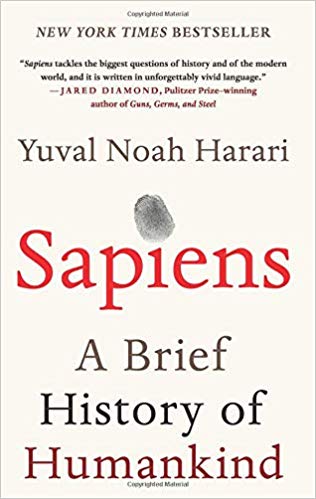Sapiens by Yuval Noah Harari

2 million years ago: Various human species inhabit Afro-Eurasia, each adapted to a specific biome. Humans are roughly in the middle of the food chain and survive mainly via plant foraging with occasional animal hunting.
300,000 years ago: Homo sapiens emerges in East Africa.
70,000 years ago: Homo sapiens undergoes a cognitive revolution, likely the result of genetic mutations. These changes give sapiens the ability to believe in and communicate fictional abstractions such as social hierarchies and moral codes. Sapiens emerges out of Africa and uses its unique cooperative abilities to conquer all of Afro-Eurasia, driving all other human species to extinction.
40,0000 years ago: Homo sapiens colonizes Australia and causes a mass extinction there.
15,000 years ago: Homo sapiens colonizes the Americas and causes a mass extinction there.
12,000 years ago: As the Ice Age ended and the world warmed, certain high-maintenance plants like wheat became more abundant. Sapiens spent more time caring for such plants until for some bands, it became a full-time sedentary job. The agricultural revolution was a disaster for Homo sapiens, giving them less-diversified and more precarious diets than their forager ancestors. Food surpluses, when they happened, were quickly lost to population growth or extorted by idle ruling elites who kept peace through arbitrary social orders.
12,000 years ago - present: Fixed settlements supplant foraging as Homo sapiens’ way of life. Commerce, political imperialism, and religions consolidate humanity into an ever-smaller number of ever-larger cultures.
500 years ago: The backwater peninsula of Europe develops some radical cultural ideas, including science (the notion that modern people and ancient people were both ignorant and that answers must be sought, not learned from the ancients) and capitalism (the notion that wealth is not zero-sum and that reinvesting profits into increasing production can produce endless economic growth). European cultures develop an aggressive drive that leads them to explore the world’s uncharted regions for knowledge and profit.
200 years ago - present: The industrial revolution allows Homo sapiens to harness energy and raw materials to an unprecedented extent. Economic growth becomes uncontrollable and seemingly without bound. Day-to-day life becomes more urbanized, anonymous, regimented, and clock-centric. Markets and governments expand their scope at the expense of traditional family and community arrangements. The new flexibility in human social structures allows humanity to handle the era’s enormous upheavals with surprisingly little bloodshed.
Primary Theses
Developments in human history are not the result of “progress” or “conquest”. Instead, they are the outcomes of irreversible one-way transitions in which going in one direction is feasible but going the other direction is not. There was never any realistic prospect for a return to foraging after agriculture, to tribalism after centralized government, to local animism after universal religion, to barter-based economies after standardized money, to superstition after science, or to agrarianism after industry.
All human “cultures” are fictional and arbitrary and have no universal basis. Every ideology and cultural idea has to be accepted dogmatically. Cultures are often created in a cynical manner to justify the political status quo.
The success of humanity’s civilization project is hard to define and even harder to measure. If the goal was evolutionary success, then humanity has succeeded. If the goal was a secure means of survival, then agriculture was a huge setback from which humanity has only recently broken even. If the goal was day-to-day human happiness, it is impossible to conclusively compare the happiness of present-day people with the people of the past.
